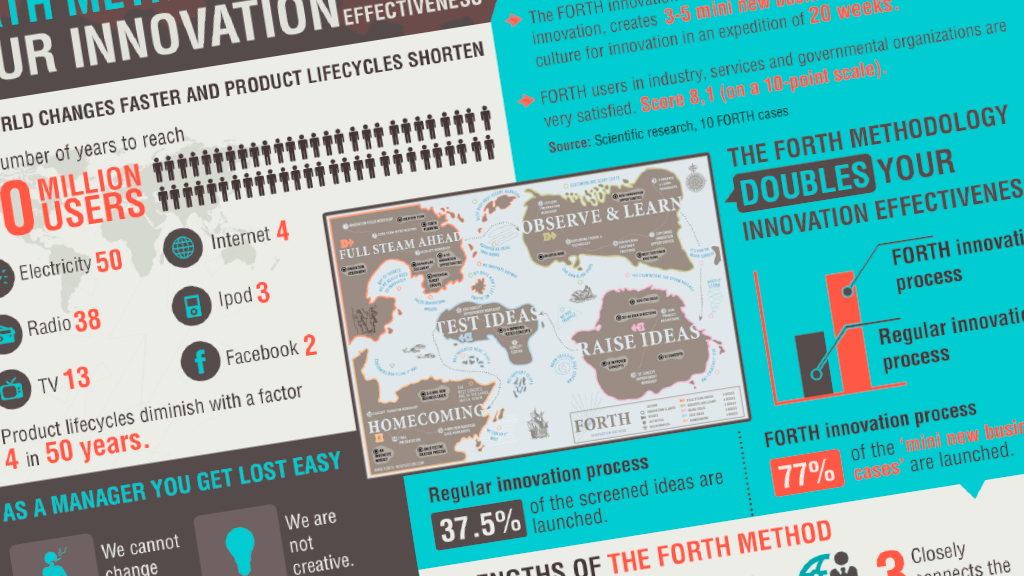10 Ways to Reduce your Failure Rate of Innovation
You are not able to stand still in this fast paced business environment, but most of the time innovation fails. Innovation process-expert Robert Cooper shows that of every seven new product/service projects, about four enter development, 1.5 are launched, and only one succeeds. Innovation is so difficult to master, indeed. I love to share with you five reasons why innovation goes wrong and give you ten ways to reduce your failure rate of innovation.
How innovation goes wrong
I encounter in practice so many people struggling with innovation. It’s has so many pitfalls. Here’s a list of five reasons why innovation goes wrong in daily practice at so many companies all over the world.
- Our short-term mindset rules. Your company focuses on getting results next quarter, as your shareholders demand profits today. In this way money and resources are dedicated to sales & marketing, instead of innovation.
- We cannot change our habits. Your company lacks the ability to invoke change, the ability to change their mindset. “My colleagues don’t think beyond what made our company successful thus far”.
- We fear failure. Your past innovations were not successful and have cost a lot of money. “Managers were fired because their launches of new products failed”.
- Our innovation process is chaos. When you lack a process and structure it’s really hard to get tangible results as it takes 18 -36 months on average to get an new idea to the market.
- Customers reject our new products and services. A lot of our new products failed because customers did not wanted them. “We struggle to get inside the head of potential purchasers of the product or service”.
10 Ways to reduce the failure rate of innovation
Although there are no easy solutions, there are ways to improve the effectiveness of innovation in your company or for your clients. I love to share with you ten actions to reduce the failure rate of innovation.
1. Create momentum for your innovation project at the start. There must be urgency otherwise innovation is considered as playtime and nobody will be prepared to go outside the box. If this is not the case: stimulate other managers to explore your fast changing environment and wait until they get nervous and will prioritize innovation.
2. Start your innovation project with a clear and concrete innovation assignment. This forces the top management, from the start, to be concrete about the market/target group for which the innovations must be developed and which criteria these new concepts must meet. This forms a great guideline underway.
3. You can invent alone, but you can’t innovate alone. Use a team approach to get both better innovation results and internal supporters for the innovative outcomes. Invite people for whom the assignment is personally relevant. Invite both people for content as for decision-making reasons. Invite also a couple of outsiders as outside-the-box thinkers. Get a good mix between men and women, young & old, et cetera.
4. A lot of managers love to be in steering groups. Don’t let them! Innovation is a difficult and dirty job. It requires not only ‘young wild dogs’ but also ‘some grey hairs’. Let the internal top problem-owner (vice-president) and important influencersparticipate in the innovation team. Let them join your journey instead of observing it from a distance.
5. Use a structured approach. To think outside the box is a good start. But you have to come back with innovative concepts, which fit the ‘in the box’ reality of your organization, otherwise nothing will happen. A structured approach helps you to connect the dots. It will also help to create a common innovation language among your people.
6. When you ideate unprepared with the usual colleagues hardly anything new appears. That’s why it is essential to get fresh insights before you start creating ideas. Let all team members visit customers and others that serve as a source of inspiration for innovation opportunities. Great ideas emerge after being inspired. So go out there yourself in a search for inspiration.
7. Winning new concepts give potential customers a concrete reason to change. It will solve relevant problems of customers. If you want to create innovative products or services start with discovering relevant customer frictions to solve. There are several ways to discover them, like personal visits, focus groups, web searching and crowd sourcing,
8. The world is changing at a faster pace. Keep a high pace in your innovation project, otherwise it becomes long-winded and boring. It gets killed when it takes too long without any progress.
9. Use the voice of the customer. How attractive are the new product or service concepts really? That’s a legitimate question. Therefore you should check the strength of the new concepts and prototypes among potential customers at the front end of innovation. Use the voice of the customer internally to convince your peers that you’re on the right track.
10. Bring back business. So, draft mini new business cases instead of coming up with post-its or mood boards. And substantiate, in a businesslike and convincing manner, to what degree and for what reason the new concept can meet all essential financial criteria of your organization.
So, I hope these 10 ways will stimulate you to improve your own innovation processes in practice and your success rate!
pic credit: Garett LeSage -flickr.com









